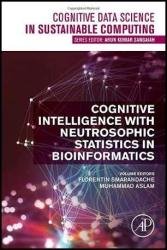 Название: Cognitive Intelligence with Neutrosophic Statistics in Bioinformatics
Название: Cognitive Intelligence with Neutrosophic Statistics in BioinformaticsАвтор: Florentin Smarandache, Muhammad Aslam
Издательство: Academic Press/Elsevier
Серия: Cognitive Data Science in Sustainable Computing
Год: 2023
Страниц: 695
Язык: английский
Формат: pdf
Размер: 20.6 MB
Cognitive Intelligence with Neutrosophic Statistics in Bioinformatics investigates and presents the many applications that have arisen in the last ten years using neutrosophic statistics in bioinformatics, medicine, agriculture and cognitive science. This book will be very useful to the scientific community, appealing to audiences interested in fuzzy, vague concepts from which uncertain data are collected, including academic researchers, practicing engineers and graduate students. Neutrosophic statistics is a generalization of classical statistics. In classical statistics, the data is known, formed by crisp numbers. In comparison, data in neutrosophic statistics has some indeterminacy. This data may be ambiguous, vague, imprecise, incomplete, and even unknown. Neutrosophic statistics refers to a set of data, such that the data or a part of it are indeterminate in some degree, and to methods used to analyze the data.
Neutrosophic set is a generalization of crisp set, fuzzy set, intuitionistic fuzzy set, inconsistent intuitionistic fuzzy set (picture fuzzy set, ternary fuzzy set), Pythagorean fuzzy set, Fermatean set, q-rung orthopair fuzzy set, spherical fuzzy set, and n-hyperspherical fuzzy set. Neutrosophic set has been further extended to refined neutrosophic set. The general model can be found as follows by using the curve fitting tool in MATLAB.
Key Features:
- Introduces the field of neutrosophic statistics and how it can solve problems working with indeterminate (imprecise, ambiguous, vague, incomplete, unknown) data
- Presents various applications of neutrosophic statistics in the fields of bioinformatics, medicine, cognitive science and agriculture
- Provides practical examples and definitions of neutrosophic statistics in relation to the various types of indeterminacies
Readership:
Graduate students, researchers, and professionals in applied mathematics, applied informatics, computer science, medicine, anatomy, biology, geology, agriculture, and energy.
Table of Contents:
1. Introduction to Neutrosophic Probability
2. Introduction to Neutrosophic Statistics
3. Applications
Applications of Neutrosophic Statistics to Medicine
Applications of Neutrosophic Statistics to Cognitive Data
Applications of Neutrosophic Statistics to Bioinformatics
Скачать Cognitive Intelligence with Neutrosophic Statistics in Bioinformatics